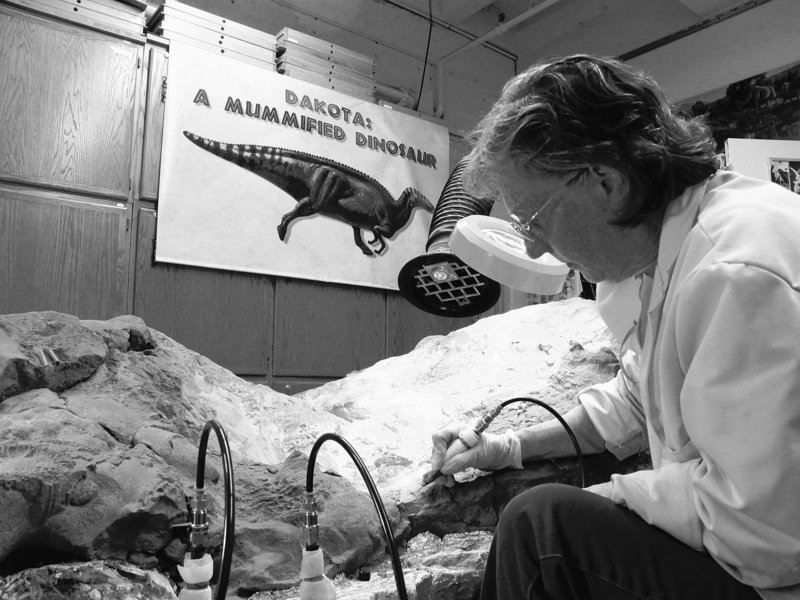BISMARCK, N.D. – Bit by bit and speck by microscopic speck, researchers working on a rare mummified dinosaur in a room beneath North Dakota’s state museum have so far removed about 1,000 pounds of rock encasing the creature’s massive body using tiny tools similar to dental instruments.
Uncovering Dakota the duckbilled dinosaur from its stone tomb has taken two years so far, and work is about 75 percent complete, said state paleontologist John Hoganson, of the North Dakota Geological Survey.
“One thousand pounds, one gram at a time,” said Ed Murphy, the state geologist. “It’s mind-numbing and hand-numbing work.”
The entire Edmontosaurus — found in North Dakota’s Badlands a decade ago and estimated to be more than 65 million years old — should be ready for display at the state museum early next year, Hoganson said.
Four workers have spent about 3,800 hours chipping away at Dakota, one of only a few mummified dinosaurs in existence.
Experts believe the specimen may have the most and best-preserved skin, along with ligaments, tendons and possibly some internal organs, of all dinosaur specimens in existence.
Dakota’s body, fossilized into stone, weighed about 4 tons before the work began, Hoganson said. About 1,000 pounds of debris and dust has been collected in an air-filtration system at the museum.
Work on a tail and an arm was completed earlier. Both are on display at the museum.
Daily progress unearthing the plant-eating beast is nearly imperceptible to most people. It takes much skill to remove rock without damaging the skin of the dinosaur, Hoganson said. “It takes so long to do very little,” he said.
Amy Sakariassen, an archaeologist who works on the dinosaur part-time, said removing a coin-size area a few millimeters thick is a good day at work.
“Your mind can’t wander,” Sakariassen said. “You have to pay attention.”
Workers use noisy, air-powered jackhammers about the size of an ink pen to uncover the dinosaur. Sakariassen said it sounds like a hive of angry bees when all four workers are removing rock from Dakota.
Tyler Lyson, a doctoral student in paleontology at Yale University, discovered the dinosaur on his uncle’s ranch near Marmarth, in southwestern North Dakota, in 1999. The specimen was unearthed about five years later.
Dakota was probably 25 feet long and weighed about 6 tons when it roamed prehistoric North Dakota, state paleontologist Becky Gould said. The dinosaur was not fully grown, she said.
It’s not known how Dakota died. “It wasn’t of old age,” said Hoganson, the state paleontologist.
Researchers estimate Dakota could have run up to 30 mph. The predator Tyrannosaurus rex could only top out at about 25 mph, Hoganson said.
There also is no evidence that Dakota had been chewed on by a meat-eating dinosaur after its demise, he said.
Dakota’s remains were fossilized in a crumpled heap, with the beast bent in half, Hoganson said. Sediment somehow covered the creature quickly, which allowed its skin to be preserved, he said.
Send questions/comments to the editors.



Success. Please wait for the page to reload. If the page does not reload within 5 seconds, please refresh the page.
Enter your email and password to access comments.
Hi, to comment on stories you must . This profile is in addition to your subscription and website login.
Already have a commenting profile? .
Invalid username/password.
Please check your email to confirm and complete your registration.
Only subscribers are eligible to post comments. Please subscribe or login first for digital access. Here’s why.
Use the form below to reset your password. When you've submitted your account email, we will send an email with a reset code.